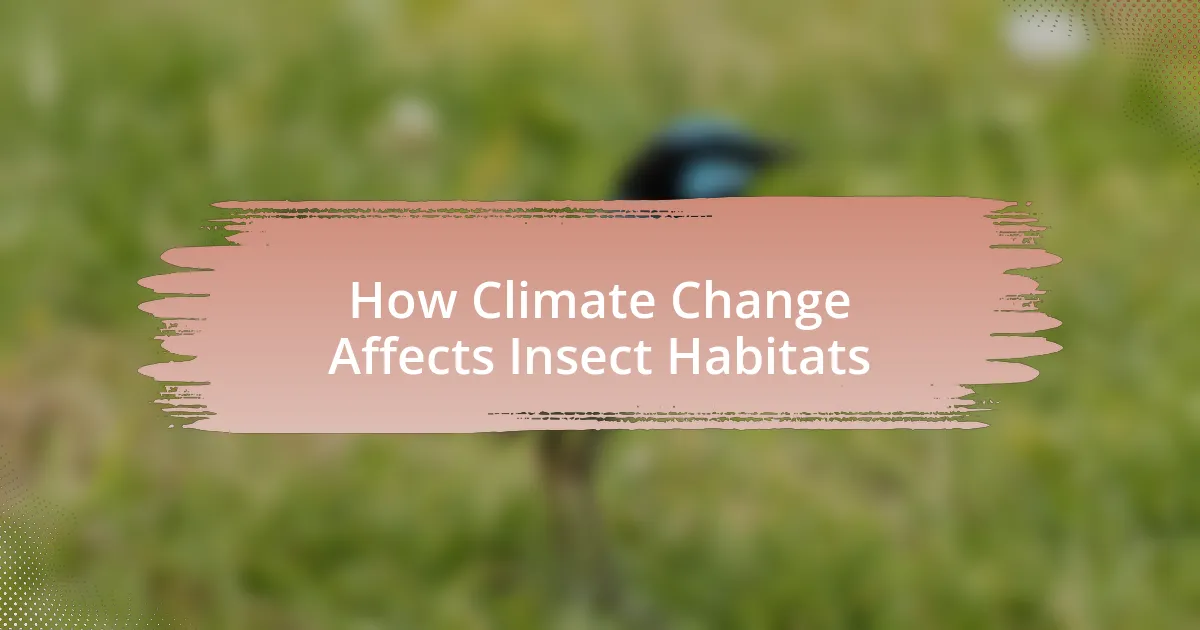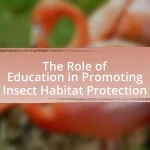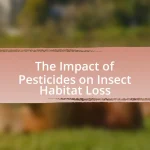Climate change significantly impacts insect habitats by altering temperature and precipitation patterns, leading to habitat loss, shifts in species distribution, and increased vulnerability to diseases and predators. Key effects include changes in food availability and breeding grounds, with many species migrating to higher elevations or latitudes as their environments become unsuitable. Specific habitats such as wetlands, forests, and alpine regions are particularly affected, resulting in declines in biodiversity and disruptions to ecosystem health. Understanding these changes is crucial, as insects play vital roles in pollination, nutrient cycling, and maintaining food webs, with implications for agricultural productivity and overall ecosystem stability.
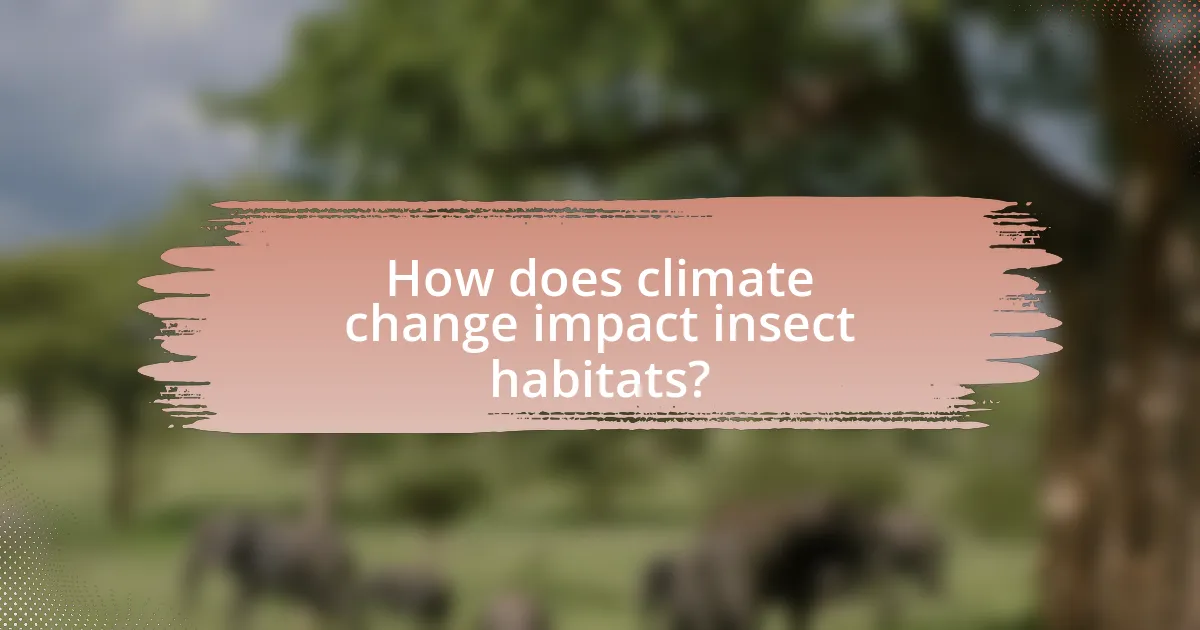
How does climate change impact insect habitats?
Climate change significantly alters insect habitats by shifting temperature and precipitation patterns, which directly affect the availability of food and suitable breeding grounds. For instance, rising temperatures can lead to the expansion of insect populations into previously inhospitable areas, while also causing habitat loss in regions that become too hot or dry. Research indicates that many insect species are experiencing range shifts; a study published in the journal “Nature Climate Change” found that 47% of insect species are moving toward higher elevations or latitudes as their current habitats become unsuitable. Additionally, changes in rainfall patterns can disrupt the ecosystems that insects rely on, leading to decreased biodiversity and altered food webs.
What are the primary effects of climate change on insect habitats?
Climate change primarily affects insect habitats by altering temperature, precipitation patterns, and the availability of resources. These changes can lead to habitat loss, shifts in species distribution, and increased vulnerability to diseases and predators. For instance, rising temperatures can expand the range of some insect species while constraining others, as seen with the northward migration of certain butterfly species in response to warming climates. Additionally, altered precipitation can affect the moisture levels in habitats, impacting food sources and breeding sites for insects. Studies have shown that these environmental changes can disrupt ecological interactions, leading to declines in insect populations and biodiversity.
How do temperature changes influence insect populations?
Temperature changes significantly influence insect populations by affecting their life cycles, reproduction rates, and distribution patterns. Warmer temperatures can accelerate development and increase reproductive rates, leading to population booms in certain species. For instance, studies have shown that species like the corn earworm can complete their life cycle faster in warmer conditions, resulting in multiple generations per season. Conversely, extreme temperature fluctuations can also lead to population declines, as many insects are sensitive to temperature extremes that can exceed their thermal tolerance. Research indicates that shifts in temperature can alter habitat suitability, pushing some species to migrate to cooler areas, while others may face local extinction if they cannot adapt.
What role does altered precipitation play in insect habitat changes?
Altered precipitation significantly impacts insect habitat changes by modifying the availability of water resources, which directly influences insect populations and their distribution. Changes in precipitation patterns, such as increased rainfall or prolonged droughts, can lead to habitat degradation, affecting food sources and breeding sites for various insect species. For instance, studies have shown that shifts in rainfall patterns can disrupt the life cycles of insects, such as mosquitoes and butterflies, by altering the timing of plant blooming and water availability, which are critical for their survival and reproduction. Additionally, regions experiencing extreme precipitation events may see a decline in insect diversity, as some species are unable to adapt to rapid environmental changes, leading to shifts in community composition and ecosystem dynamics.
Why is understanding insect habitat changes important?
Understanding insect habitat changes is important because these changes directly impact biodiversity, ecosystem health, and agricultural productivity. Insects play crucial roles in pollination, nutrient cycling, and pest control; thus, shifts in their habitats can lead to declines in these essential services. For instance, a study published in the journal “Nature” found that climate change has already altered the distribution of many insect species, with some declining by up to 50% in certain regions. This decline can disrupt food webs and lead to reduced crop yields, threatening food security. Therefore, monitoring and understanding these habitat changes is vital for conservation efforts and sustainable agricultural practices.
How do insects contribute to ecosystem health?
Insects contribute to ecosystem health by serving as pollinators, decomposers, and a food source for other organisms. Pollinators, such as bees and butterflies, facilitate the reproduction of flowering plants, which are essential for food production and biodiversity. Decomposers, including various beetles and ants, break down organic matter, recycling nutrients back into the soil, which supports plant growth. Additionally, insects provide a critical food source for birds, mammals, and other wildlife, maintaining the balance of food webs. Research indicates that approximately 75% of flowering plants rely on animal pollination, highlighting the vital role insects play in sustaining ecosystems.
What are the implications of insect habitat loss for biodiversity?
Insect habitat loss significantly reduces biodiversity by disrupting ecosystems and diminishing species interactions. The decline in insect populations, which serve as pollinators, decomposers, and food sources for other animals, leads to a cascade of negative effects on plant reproduction and animal survival. For instance, studies indicate that a 75% decline in insect biomass has been observed in some regions, which correlates with a decrease in bird populations that rely on insects for food. This loss of insects can result in decreased plant diversity, as many plants depend on specific insects for pollination, ultimately affecting the entire food web and ecosystem stability.
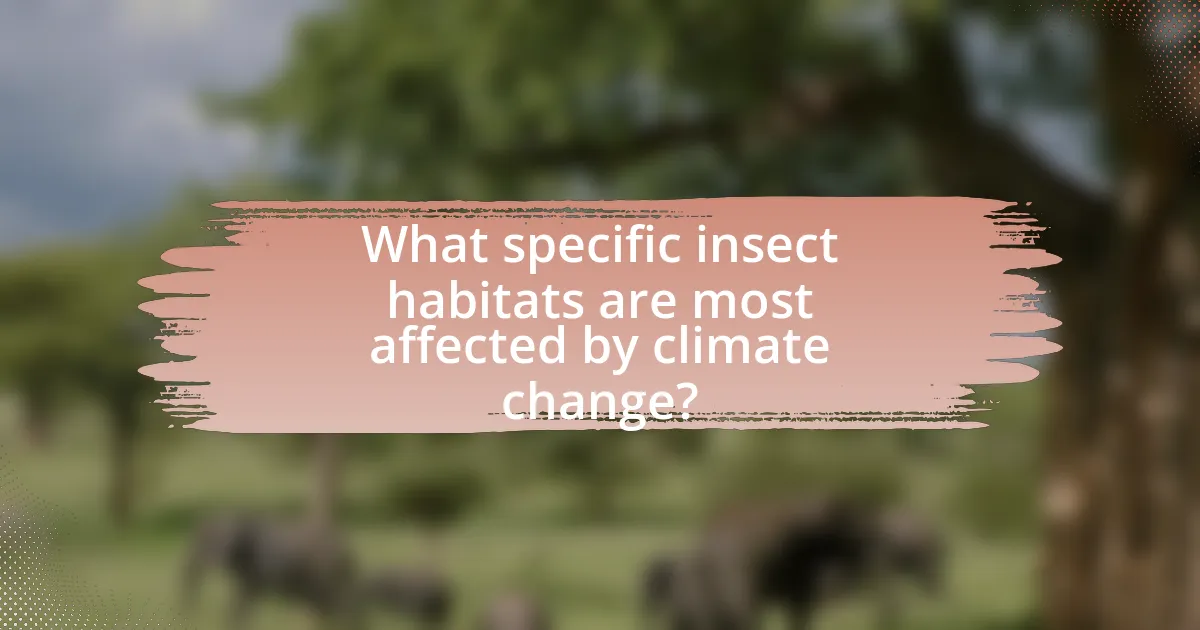
What specific insect habitats are most affected by climate change?
Wetlands, forests, and alpine regions are specific insect habitats most affected by climate change. Wetlands experience altered hydrology and increased salinity, which disrupts the life cycles of aquatic insects. Forests face shifts in temperature and precipitation patterns, leading to changes in species composition and increased vulnerability to pests. Alpine regions are particularly sensitive to temperature increases, resulting in habitat loss for cold-adapted insect species. Studies indicate that these habitats are experiencing significant biodiversity loss and shifts in community dynamics due to climate-related changes.
Which ecosystems are vulnerable to climate change impacts on insects?
Terrestrial ecosystems, particularly forests, grasslands, and wetlands, are vulnerable to climate change impacts on insects. These ecosystems experience shifts in temperature and precipitation patterns, which can disrupt insect life cycles, alter habitat availability, and affect food sources. For instance, studies have shown that rising temperatures can lead to mismatches between insect emergence and the availability of flowering plants, crucial for pollinators. Additionally, aquatic ecosystems, such as rivers and lakes, are also at risk, as increased temperatures and altered water levels can affect aquatic insect populations, which are vital for food webs.
How does climate change affect forest insect populations?
Climate change significantly affects forest insect populations by altering their habitats, life cycles, and interactions with other species. Rising temperatures can lead to increased insect reproduction rates and expanded ranges, allowing species to thrive in previously inhospitable areas. For instance, studies have shown that warmer winters enable pests like the mountain pine beetle to survive and reproduce at higher rates, resulting in widespread tree mortality. Additionally, changes in precipitation patterns can affect the availability of food sources and disrupt the timing of life cycle events, such as mating and feeding, which can further impact insect populations.
What changes occur in aquatic insect habitats due to climate change?
Climate change leads to significant alterations in aquatic insect habitats, primarily through temperature increases, altered precipitation patterns, and changes in water quality. Rising temperatures can result in reduced dissolved oxygen levels, which negatively impacts aquatic insect survival and reproduction. Additionally, altered precipitation patterns can lead to increased flooding or drought conditions, disrupting the habitats of these insects. Changes in water quality, such as increased nutrient runoff from heavy rainfall, can lead to harmful algal blooms that further degrade aquatic ecosystems. These factors collectively threaten the biodiversity and ecological balance of aquatic insect populations.
What are the consequences of habitat changes for specific insect species?
Habitat changes significantly impact specific insect species by altering their food sources, reproductive patterns, and survival rates. For instance, the decline of native plant species due to habitat loss can lead to decreased populations of specialized herbivorous insects that rely on those plants for sustenance. Research indicates that the Monarch butterfly population has declined by over 90% in North America, primarily due to habitat destruction and the loss of milkweed, its primary food source. Additionally, changes in temperature and precipitation patterns can disrupt the life cycles of insects, leading to mismatches in timing between insects and their food sources or predators. This can result in reduced reproductive success and increased mortality rates among affected species.
How do migratory patterns of insects shift with climate change?
Migratory patterns of insects shift with climate change primarily due to alterations in temperature and habitat availability. As global temperatures rise, many insect species are moving their migration routes northward or to higher elevations to find suitable climates. For instance, studies have shown that the migration of the monarch butterfly has advanced by several weeks in response to warmer spring temperatures. Additionally, changes in precipitation patterns can affect the availability of food sources and breeding grounds, further influencing migration timing and routes. Research published in the journal “Ecology Letters” indicates that these shifts can disrupt ecosystems and affect pollination and food webs, highlighting the significant impact of climate change on insect migratory behavior.
What are the survival challenges faced by endangered insect species?
Endangered insect species face survival challenges primarily due to habitat loss, climate change, pollution, and invasive species. Habitat loss occurs as urbanization and agricultural expansion reduce the natural environments necessary for their survival. Climate change alters temperature and precipitation patterns, disrupting life cycles and food availability. Pollution, particularly from pesticides and chemicals, directly harms insect populations and their ecosystems. Invasive species can outcompete native insects for resources, further threatening their survival. These factors collectively contribute to the decline of insect biodiversity, which is critical for ecosystem health and function.
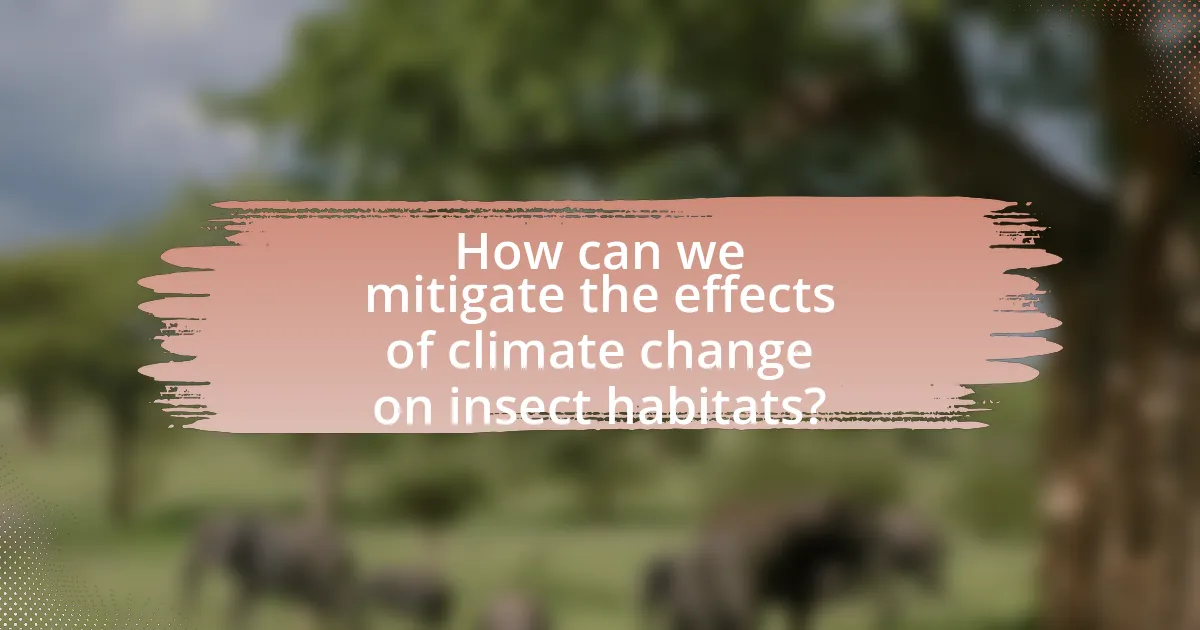
How can we mitigate the effects of climate change on insect habitats?
To mitigate the effects of climate change on insect habitats, we can implement habitat restoration and conservation strategies. These strategies include preserving existing habitats, creating corridors to connect fragmented ecosystems, and restoring degraded areas to enhance biodiversity. Research indicates that maintaining diverse plant communities can support a wider range of insect species, which is crucial as climate change alters temperature and precipitation patterns. For instance, a study published in the journal “Ecological Applications” by Didham et al. (2012) highlights that habitat connectivity significantly improves insect resilience to climate stressors. By prioritizing these actions, we can help sustain insect populations and their ecosystems in the face of climate change.
What strategies can be implemented to protect insect habitats?
To protect insect habitats, implementing strategies such as creating protected areas, restoring native vegetation, and reducing pesticide use is essential. Protected areas serve as refuges for various insect species, allowing them to thrive without the pressures of habitat destruction. Restoring native vegetation enhances biodiversity and provides food and shelter for insects, which is crucial for their survival. Additionally, reducing pesticide use minimizes harmful impacts on insect populations, as studies have shown that pesticides contribute significantly to declines in insect diversity and abundance. These strategies collectively contribute to the conservation of insect habitats, which are vital for ecosystem health and resilience.
How can habitat restoration efforts support insect populations?
Habitat restoration efforts can significantly support insect populations by re-establishing native vegetation and improving ecosystem health. Restored habitats provide essential resources such as food, shelter, and breeding sites, which are crucial for the survival of various insect species. For instance, studies have shown that areas with restored native plants can increase insect diversity by up to 50%, as these plants offer better nutrition and habitat compared to non-native species. Furthermore, habitat restoration can enhance soil quality and water availability, creating a more favorable environment for insects to thrive.
What role do conservation policies play in mitigating climate impacts?
Conservation policies play a crucial role in mitigating climate impacts by protecting ecosystems that serve as carbon sinks and enhancing biodiversity. These policies, such as the establishment of protected areas and sustainable land management practices, help preserve habitats that are vital for various species, including insects, which are essential for pollination and nutrient cycling. For instance, the implementation of the Convention on Biological Diversity has led to the protection of over 15% of terrestrial and inland water areas globally, contributing to climate resilience by maintaining ecosystem functions. Additionally, research indicates that conserving natural habitats can reduce greenhouse gas emissions by sequestering carbon, thereby directly addressing climate change.
What actions can individuals take to support insect habitats?
Individuals can support insect habitats by creating diverse gardens that include native plants, which provide food and shelter for various insect species. Research shows that native plants are more beneficial for local ecosystems, as they co-evolved with native insects, offering essential resources. Additionally, individuals can reduce pesticide use, as chemicals can harm beneficial insects and disrupt their habitats. Implementing practices such as composting and maintaining natural areas in yards can also enhance soil health and promote insect populations. Furthermore, individuals can participate in local conservation efforts, such as habitat restoration projects, which directly contribute to the preservation of insect habitats.
How can urban planning incorporate insect-friendly practices?
Urban planning can incorporate insect-friendly practices by integrating green spaces, native vegetation, and sustainable water management systems. Green spaces, such as parks and community gardens, provide habitats for various insect species, promoting biodiversity. The use of native plants is crucial, as they support local insect populations, including pollinators like bees and butterflies, which are essential for ecosystem health. Additionally, sustainable water management, such as rain gardens and permeable pavements, can create microhabitats that retain moisture and support insect life. Research indicates that urban areas with diverse green infrastructure can enhance insect diversity and abundance, thereby contributing to ecological resilience in the face of climate change.
What are some best practices for creating supportive environments for insects?
Creating supportive environments for insects involves implementing practices that enhance their habitats and promote biodiversity. Planting native flora is essential, as these plants provide food and shelter for local insect species, which are adapted to thrive in specific ecosystems. Maintaining diverse plant life increases habitat complexity, offering various niches for different insect species.
Minimizing pesticide use is another critical practice, as chemicals can harm beneficial insects and disrupt ecological balance. Instead, integrated pest management strategies can be employed to control pests while protecting insect populations.
Providing water sources, such as shallow dishes or ponds, supports insects’ hydration needs, especially during dry periods. Additionally, creating undisturbed areas, like leaf litter or brush piles, offers shelter and breeding sites for insects.
Lastly, promoting organic gardening practices can enhance soil health, which in turn supports a diverse insect community. Research indicates that diverse ecosystems with healthy soil are more resilient to climate change, thereby supporting insect populations effectively.
